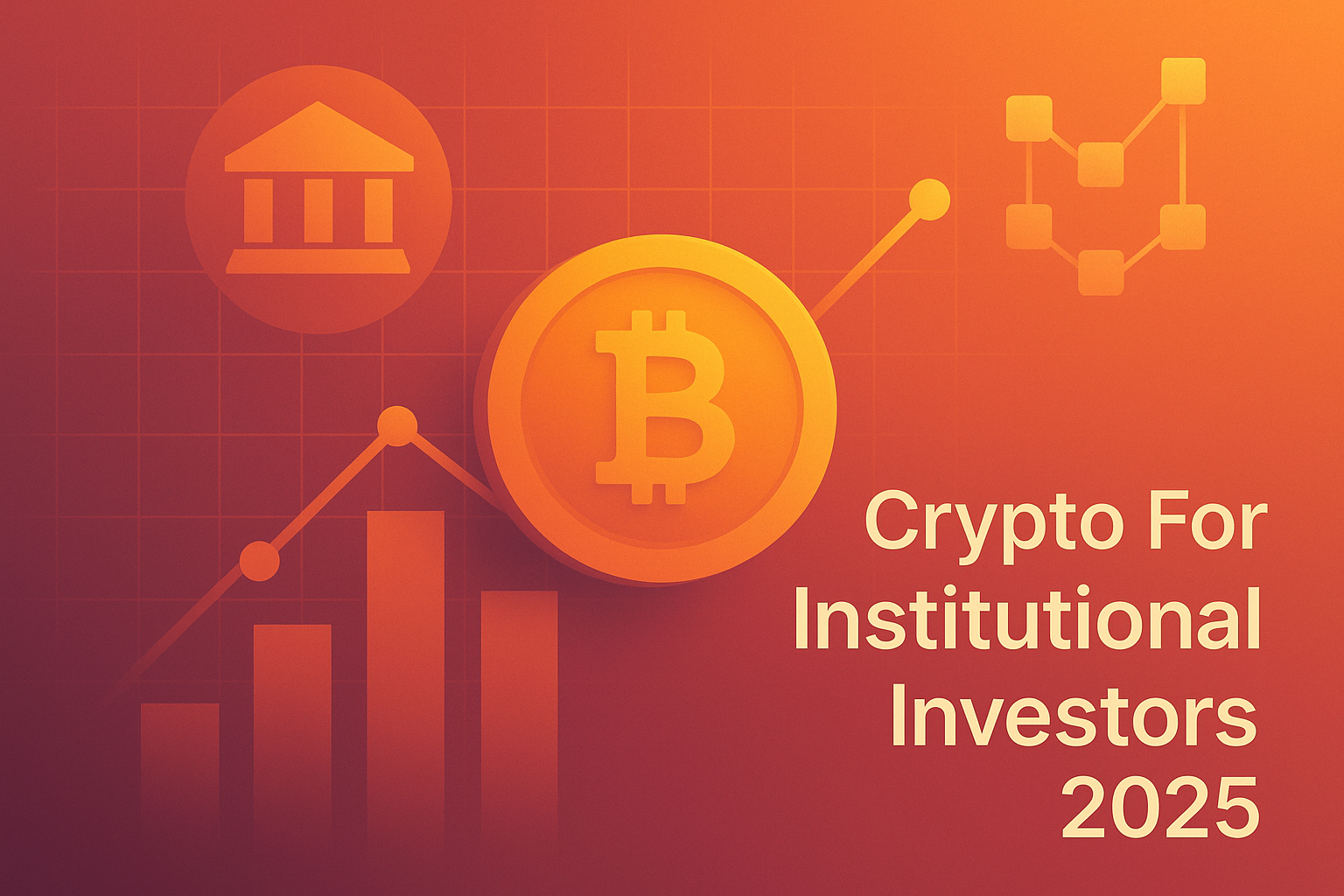Big organizations are turning their attention towards crypto in 2025. And that’s creating waves. So, here’s everything you need to know about crypto for institutional investors 2025.
Once upon a time, crypto was a wild west playground. Mostly retail traders, big risks, and even bigger headlines. But that era is quickly fading. In 2025, the game has changed, and the new players wear suits.
From pension funds to hedge funds, everyone’s eyeing the digital frontier. Why? Because crypto isn’t just speculation anymore. It’s a strategy. Solid infrastructure, smarter tools, and clearer rules are making crypto for institutional investors in 2025 not only possible but powerful. Plus, with increasing use cases of how businesses can use crypto in the real world, the space is growing rapidly.
This shift isn’t a trend. It’s a transformation. And institutions aren’t dipping their toes. They’re diving in.
So, what’s fueling this confidence? What makes crypto ready for the big leagues? Let’s explore how enterprise blockchain, institutional-grade platforms, and tokenized assets are shaping a smarter, safer, and more scalable future for finance.
The Rise of Institutional Crypto Adoption

Credits: Photo by David McBee
A few years ago, crypto was still viewed as a speculative playground. Risky, unregulated, and full of unknowns. Most big institutions stayed far away, unsure whether digital assets were a bubble or a breakthrough. But fast forward to 2025, and the landscape looks completely different.
Today, crypto for institutional investors 2025 isn’t just a possibility. It’s a priority.
From Curiosity to Commitment
Back in 2017, when Bitcoin first crossed major headlines, institutions were curious but cautious. Some dabbled. Most watched from the sidelines.
By 2020, companies like MicroStrategy and Tesla had stirred the pot. And in the years that followed, the dominoes started falling. What began as a few bold bets has now turned into full-fledged investment strategies. The shift was slow at first. But once the infrastructure matured and the regulatory fog began to clear, big money started moving in.
And now? It’s full steam ahead.
Who’s Leading the Charge?
It’s not just the hedge funds anymore. The roster has expanded dramatically.
- Pension funds are diversifying with long-term crypto exposure.
- Endowments and university funds are dipping into blockchain ventures.
- Insurance companies are using tokenized assets for yield strategies.
- Sovereign wealth funds have started partnering with Web3 projects directly.
Even conservative institutions, known for their risk-averse nature, are now exploring digital assets as part of modern portfolio theory. They’re not throwing out traditional models. Instead, they’re adapting them to this new digital age.
Turning Points That Changed the Game
Several key moments helped unlock this new wave of adoption:
- The arrival of spot Bitcoin and Ethereum ETFs in multiple jurisdictions made access seamless.
- Enterprise-grade custody solutions addressed long-standing fears about security.
- Transparent compliance tools helped firms meet AML/KYC obligations without friction.
- And importantly, institutional trading platforms emerged. Offering deep liquidity, robust risk controls, and tailored support for large-volume trading.
Together, these pieces gave institutions what they were waiting for: trust, transparency, and tools built just for them.
Why Institutions Are All In
At its core, crypto offers something traditional markets can’t: programmable, borderless, 24/7 finance. That kind of flexibility is hard to ignore.
Add in real yield opportunities, inflation-resistant assets, and access to entirely new digital economies. And it’s easy to see why crypto now plays a serious role in modern investment strategy.
Plus, the long-term outlook matters. Institutions think in decades, not days. They see the roadmap for tokenization, blockchain-based finance, and AI-driven smart contracts. And they’re betting early to secure their advantage.
From Niche to Normal
In 2025, investing in crypto is no longer a fringe idea in boardrooms. It’s part of the conversation. In some cases, it’s already written into the investment mandate.
And the numbers back it up. Institutional crypto inflows have hit record highs. More funds are launching digital asset arms. And traditional financial institutions, banks, brokers, asset managers, are scrambling to build crypto-native teams.
In short, we’ve moved from “Why crypto?” to “Why not?”
The rise of institutional adoption didn’t happen overnight. It was built step by step, on trust, on infrastructure, and on vision. And now, in this new chapter, institutional players aren’t just joining the crypto world. They’re helping shape it.
And Investors Collective is playing a role in this adoption by sharing real-time insights, verified signals, and educational material on institutional-grade crypto.
Exploring the Institutional-Grade Crypto Infrastructure

Credits: Photo by RDNE Stock project
It’s one thing for institutions to be interested in crypto. But it’s another thing entirely for them to actually invest. Curiosity alone doesn’t move billions. Trust does. And that trust comes from having solid, purpose-built infrastructure that can handle the weight of serious money.
That’s exactly what we’re seeing in crypto for institutional investors 2025. A landscape built not for hobbyists, but for heavyweight players.
Stronger Custody, Smarter Security
Let’s start with the most basic requirement: keeping assets safe.
Unlike retail investors, institutions can’t just stash their crypto in a browser wallet or mobile app. We’re talking about millions, sometimes billions, in digital assets. Losing access isn’t an option. Neither is a hack.
So, institutional-grade custody solutions have stepped up in a big way.
From cold storage vaults to multi-party computation (MPC) wallets, today’s custody services offer layers of protection. Players like Anchorage Digital, Fireblocks, and Coinbase Prime now provide secure environments with robust insurance, role-based access, and instant compliance reporting. In short, everything institutions need to sleep soundly at night.
And yes, some are even integrating custody with trading, making the process seamless from wallet to execution.
Compliance Isn’t a Buzzword… It’s a Dealbreaker
If there’s one thing that keeps institutional compliance officers up at night, it’s the fear of crossing regulatory lines. In traditional finance, rules are the backbone of trust. The same is true in crypto.
That’s why modern crypto infrastructure now comes baked with compliance features by design.
Advanced on-chain analytics tools help firms monitor wallet activity in real-time. Automated KYC/AML systems flag suspicious behavior before it becomes a problem. And regulatory frameworks like MiCA in the EU and improved SEC clarity in the U.S. are making it easier than ever to operate within legal bounds.
Simply put, institutions want clarity. And now they’re finally getting it.
Trading Tools Built for Giants
Next comes execution. Institutions can’t just log into a retail exchange and place trades like an everyday user. They need access to deep liquidity, minimal slippage, and full reporting tools.
Enter: prime brokerage services for crypto.
Firms like FalconX, BitGo, and Copper are offering high-touch trading platforms specifically designed for institutional needs. We’re talking about:
- Smart order routing
- Custom API integrations
- Margin and lending solutions
- And yes, round-the-clock human support
Moreover, institutional investors in 2025 often rely on OTC desks to move large volumes without moving the market. These private, over-the-counter channels offer discretion, price stability, and bespoke trade execution.
It’s a completely different universe than the average crypto app.
Wrapped in a Professional Experience
One of the most underrated aspects of this infrastructure is the user experience itself. Institutions want dashboards, analytics, real-time alerts, downloadable reports, and integration with existing financial software.
And now, they’re getting it.
Everything from risk dashboards to tax reporting tools is becoming plug-and-play. That level of sophistication is exactly what helps traditional finance feel at home in this new world.
A Foundation for the Future
Ultimately, none of this evolution happened by accident. Builders listened. Innovators adapted. And over time, crypto’s infrastructure evolved from DIY to enterprise-ready. Now, institutions have the tools to operate with confidence, speed, and precision. The rails are finally in place.
And thanks to this transformation, crypto for institutional investors 2025 isn’t a gamble. It’s a well-oiled, fully supported opportunity waiting to be seized.
Enterprise Blockchain in Action

Credits: Image on Freepik
Blockchain isn’t just about coins anymore. While cryptocurrencies still grab the headlines, the real magic is happening behind the scenes. And it’s called enterprise blockchain.
In crypto for institutional investors 2025, this side of the technology is taking center stage. Quietly but powerfully, enterprise-grade blockchains are transforming how companies do business, how assets move, and how trust is built between parties. No hype. Just results.
Public vs. Private: The Blockchain Split
Not all blockchains are built the same. Some, like Bitcoin or Ethereum, are public and permissionless. Anyone can join, anyone can build. These are the open playgrounds of the crypto world.
But enterprise blockchains? They’re a different beast.
They are permissioned, private, and built for business. Think of them as gated communities where only verified participants can enter and transact. This setup offers more control, faster speeds, and compliance.
For institutions that deal with sensitive data or require strict oversight, this model is perfect.
Real-World Use Cases That Matter
Now let’s talk about real-world impact. Because this isn’t a theory. It’s already happening.
Supply Chain Transparency
Companies like IBM and Maersk use blockchain to track goods across global supply chains. Every touchpoint, from factory to shelf, is recorded on-chain, reducing fraud and increasing efficiency.
Cross-Border Settlements
Big banks like JPMorgan are leading with platforms like Onyx, using blockchain to settle cross-border payments in seconds, not days. No more delays. No more expensive intermediaries.
Tokenization of Assets
From real estate to corporate bonds, blockchain lets institutions tokenize just about anything. That means better liquidity, fractional ownership, and automated settlements. All on-chain.
Healthcare & Identity
Some governments and enterprises are exploring blockchain for secure digital identity systems and medical data sharing. Privacy meets accessibility, without the paperwork mess.
These aren’t pilot projects anymore. They’re real deployments with measurable ROI.
Enter the Power Players
Several platforms are driving this quiet revolution.
- Hyperledger Fabric – Ideal for supply chain, finance, and enterprise applications.
- R3 Corda – Focused on regulated financial institutions.
- Quorum (by JPMorgan) – Tailored for high-speed enterprise use.
- Avalanche Evergreen – A newer entry designed specifically for institutional blockchain deployment.
These networks provide the backbone that institutions trust. They’re customizable, secure, and built to integrate with legacy systems.
Collaboration, Not Isolation
Another key trend? Consortiums.
Enterprises are realizing they can do more when they work together. So instead of building their own siloed solutions, they’re joining blockchain consortiums. Think of them as industry clubs where standards are shared, costs are split, and innovation happens faster.
For instance, trade finance groups, logistics giants, and insurance providers are banding together to create shared ledgers that benefit everyone. And this collective approach makes adoption smoother, cheaper, and far more scalable.
Why It All Matters
So, why should investors care?
Because enterprise blockchain isn’t just backend plumbing. It’s an investment signal. When the biggest names in business start building with blockchain, it validates the tech. It shows that crypto isn’t just speculative. It’s structural.
And for anyone involved in crypto for institutional investors 2025, understanding this layer is essential. It reveals where the real growth is happening. It shows how blockchain is quietly becoming the digital fabric of global finance and commerce.
In short, enterprise blockchain isn’t loud. It doesn’t trend on Twitter. But it’s working tirelessly behind the scenes. Powering systems, securing data, and reshaping industries one block at a time.
Cryptocurrency Portfolio Strategies for Institutions

Credits: Image by Pabitra Kaity from Pixabay
So, the infrastructure is ready. The blockchain tools are humming in the background. Regulations? Much clearer now. But what do institutions actually do with all this? How do they build smart, balanced, and forward-thinking portfolios in a market as wild as crypto?
Well, crypto for institutional investors in 2025 isn’t about throwing darts. It’s about data, discipline, and a very strategic mix of old-school portfolio theory and new-age digital assets.
Let’s break down how the pros are doing it.
Core Holdings: Building a Digital Foundation
Every solid portfolio starts with a core.
For most institutions, that means Bitcoin and Ethereum. These are still the heavyweights. Widely adopted, liquid, and time-tested. Bitcoin is often treated like digital gold, a hedge against inflation and global uncertainty. Ethereum, on the other hand, is the tech layer that powers decentralized finance, smart contracts, and Web3.
Together, they form the bedrock of many institutional crypto portfolios. Steady. Familiar. Scalable.
Beyond BTC and ETH: Strategic Diversification
But institutions aren’t stopping at the top two anymore. Not in 2025. They’re branching out into a curated mix of:
- Layer 1 blockchains like Solana, Avalanche, and Sui
- Infrastructure tokens powering storage, data, and identity (think Chainlink or Arweave)
- DeFi protocols that offer yield opportunities with added security layers
- Stablecoins for liquidity and cash-like exposure within crypto-native environments
These assets help spread risk and tap into the growth of different corners of the digital economy.
Still, it’s not about chasing moonshots. It’s about finding balance between growth and safety. Just with a crypto twist.
Active vs. Passive: A New Kind of Debate
In traditional markets, the active vs. passive debate has raged for decades. Now, it’s showing up in crypto too. Some institutions prefer passive exposure, leaning into products like:
- Crypto index funds
- Sector-specific ETFs
- Token baskets tracking the top 10 or top 50 assets
These are great for institutions looking to gain broad market exposure without diving too deep into individual coins. But others are going fully active. Hiring crypto-native fund managers, building in-house research desks, and running algorithmic trading models across 24/7 markets.
It all depends on their risk appetite, expertise, and investment horizon.
Managing Risk in a Volatile Market
Crypto can still be chaotic. And for institutions, risk management isn’t optional. It’s built into every decision. Here’s how they’re staying ahead:
- Position sizing: No single asset dominates the portfolio.
- Stop-loss orders and automated rebalancing keep emotions out of trading.
- Value at Risk (VaR) models are adapted to crypto’s volatility.
- Insurance products are used to cover smart contract exploits and exchange risks.
They also diversify across custodians, jurisdictions, and even blockchains to reduce systemic exposure. In 2025, managing risk isn’t about avoiding crypto. It’s about understanding it.
Yield Hunting: But with Caution
Institutions also explore staking, lending, and liquidity provisioning to generate yield. But unlike retail yield-chasers, they do it with due diligence. They partner with vetted platforms. They demand real-time audits. And they always ask: What’s backing this yield?
Because high returns are great. But only if they come with real safeguards.
Finally
Portfolio strategy, in the context of crypto for institutional investors 2025, is all about structure. Institutions are treating crypto like any other asset class. Thoughtfully, cautiously, and with a long-term lens.
They’re not chasing hype. They’re building portfolios designed to last. Layered with resilience, driven by data, and flexible enough to evolve as the market does. And honestly? That’s exactly the kind of thinking crypto needs right now.
Security, Custody & Risk Concerns in Crypto for Institutional Investors

Credits: Photo by Ewan Kennedy on Unsplash
Crypto can be a bit of a minefield. One wrong click, one shady platform, and boom, millions gone. That’s scary enough for everyday investors. But when institutions enter the game? The stakes are way higher.
That’s why, in the world of crypto for institutional investors 2025, security isn’t just important. It’s non-negotiable.
Custody: Where Are the Keys?
The first big question every institution asks is simple: Where do we keep our crypto?
You can’t exactly toss millions in tokens into a browser extension wallet. And no, sticky notes with seed phrases won’t cut it. Institutions need secure, compliant, and auditable custody solutions. And luckily, 2025 delivers.
Top-tier platforms now offer multi-party computation (MPC), hardware security modules (HSMs), and cold storage vaults housed in undisclosed underground bunkers (yes, literally). Whether it’s Coinbase Prime, Anchorage Digital, or BitGo, today’s custodians are armed to the teeth with both tech and legal firepower.
Plus, most are regulated and insured, which brings peace of mind to even the most cautious CFOs.
Third-Party vs. Self-Custody
Now here’s where it gets interesting.
Some institutions choose third-party custody. Essentially outsourcing security to a trusted service provider. Others opt for self-custody, setting up internal infrastructure and security teams.
Both approaches have pros and cons.
- Third-party custody offers convenience, support, and regulatory clarity.
- Self-custody provides control, flexibility, and removes reliance on external partners.
The choice usually comes down to one thing: how much responsibility an institution is willing to take on.
Internal Threats: Not Just Hackers
Everyone worries about external hacks. But in reality, insider threats are just as dangerous. Especially for institutions.
That’s why modern crypto custody comes with features like:
- Multi-signature authorization
- Role-based permissions
- Audit trails and alerts
- Timed withdrawals and transaction approvals
In other words, nobody, no single person, can move funds on their own. Every action leaves a fingerprint. Every transaction has built-in checks. And that’s exactly how it should be.
Smart Contracts Can Be… Not So Smart
Institutions diving into DeFi have to deal with smart contract risk. The risk that code can fail or be exploited. And while DeFi platforms offer exciting yield opportunities, they also come with their fair share of bugs and backdoors. To manage this, institutions rely on:
- Third-party audits
- Real-time monitoring tools
- Insurance coverage for smart contract breaches
- Bug bounty platforms that reward white-hat hackers for finding flaws before the bad guys do
In 2025, no serious institution enters a smart contract ecosystem without a full risk assessment. And often, a backup plan too.
Cybersecurity: The Digital Armor
Security isn’t just about wallets and contracts. It’s about the entire digital environment.
That means firewalls, VPNs, endpoint protection, staff training, phishing simulations. The full cybersecurity stack. Even simple things like multi-factor authentication (MFA) can stop a disaster before it starts.
More importantly, institutions treat security as a living system. It’s not a one-time setup. It’s an ongoing battle. And they train for it.
Insurance: The Safety Net
Sometimes, things go wrong anyway. That’s where crypto insurance comes in.
In 2025, specialized insurance products now cover:
- Custody breaches
- Exchange failures
- Smart contract exploits
- Even reputational risks from failed crypto ventures
These policies don’t come cheap, but they offer a vital safety net. And, more importantly, they make crypto investment more acceptable to boards and regulators.
Trust Is Everything
In traditional finance, trust is built on time-tested systems. In crypto, trust is earned through bulletproof security, transparent custody, and proactive risk management.
So, when we talk about crypto for institutional investors in 2025, we’re really talking about a shift from fear to confidence. And that confidence is powered by one thing: the relentless commitment to keeping digital assets safe. No matter what.
Tokenization of Real-World Assets (RWA)

Credits: Image on Freepik
Imagine owning a slice of a New York skyscraper, a fraction of a Picasso painting, or a small piece of a rare diamond. All from your laptop. Welcome to the world of tokenized real-world assets, where anything of value can become digital, divisible, and tradable.
And in crypto for institutional investors 2025, this trend isn’t just exciting. It’s game-changing.
What Is Tokenization, Really?
Let’s break it down.
Tokenization means turning physical or traditional assets, like real estate, bonds, commodities, or even fine art, into digital tokens that live on a blockchain. Each token represents ownership, just like a share in a company. But unlike old-school systems, these tokens are programmable, transparent, and easy to move across borders.
Suddenly, assets that were once slow and illiquid become agile and accessible. That’s a big win for institutions.
Why Institutions Are All In
For years, institutions have struggled with the limitations of traditional markets. Settlements take days. Paperwork piles up. Liquidity is often a headache.
But with tokenization, things change.
- Faster settlement times, from T+2 to real-time
- Fractional ownership, opening access to high-value assets
- Lower entry barriers, thanks to smaller minimums
- 24/7 global access to assets that used to be stuck in local markets
For institutions, this means higher efficiency, lower costs, and new opportunities for portfolio diversification.
What’s Being Tokenized?
Just about everything. In 2025, the list keeps growing:
- Government bonds and corporate debt
- Commercial real estate and rental properties
- Precious metals like gold and silver
- Treasury bills, now wrapped into yield-generating stablecoins
- Even luxury goods and intellectual property rights
Some funds are even tokenizing private equity positions, giving investors a way to trade previously locked-up capital on secondary markets. It’s not just innovation. It’s transformation.
Platforms Making It Possible
Several blockchain platforms are leading the charge in RWA tokenization. Some worth knowing:
- Ondo Finance – Specializing in tokenized treasuries and fixed-income assets
- Securitize – Bridging real-world securities with compliant token offerings
- Maple Finance and Centrifuge – Connecting institutional capital with tokenized credit markets
- Polymesh and Avalanche Evergreen – Built for regulated, institution-grade asset tokenization
These platforms are designed with compliance and security in mind, offering peace of mind while pushing boundaries.
Tokenized Assets in a Portfolio
Here’s where it gets interesting. Institutions are beginning to treat tokenized RWAs as core parts of their portfolio mix. Why? Because they offer real-world value, with crypto-native benefits. That means:
- Stable yield, often backed by short-term debt instruments
- On-chain transparency into the underlying assets
- Programmability, allowing for smart contract-based payouts and automated governance
Tokenized assets are no longer a nice-to-have. They’re fast becoming a must-have in the institutional playbook.
Challenges Still Remain
Of course, it’s not all smooth sailing. Tokenization brings big benefits, but it also raises new questions.
- How do you legally enforce ownership of a digital token tied to a physical asset?
- What happens if the issuer disappears or defaults?
- How do regulators handle cross-border token trades?
Thankfully, many of these challenges are being addressed with better frameworks, clearer regulations, and smarter platforms.
Still, due diligence matters. Now more than ever.
A Bridge Between Two Worlds
At its core, tokenization is more than just a tech upgrade. It’s a bridge between traditional finance and the digital frontier. It gives institutions the best of both worlds: the familiarity of real assets and the flexibility of blockchain.
So in the evolving world of crypto for institutional investors 2025, tokenized real-world assets aren’t just a trend. They’re a powerful tool. Reshaping how wealth is built, accessed, and exchanged across the globe.
Institutional Crypto Regulatory and Policy Landscape in 2025

Credits: Photo by Markus Winkler
Crypto and regulation haven’t always been the best of friends. In the early days, it felt like crypto was sprinting ahead while regulators jogged behind with a confused look and a rulebook from the 1980s.
But fast forward to today, and things look very different. In crypto for institutional investors 2025, regulation isn’t just catching up. It’s helping lead the way.
From Chaos to Clarity
Just a few years ago, institutions avoided crypto not because they didn’t believe in it. But because the rules were murky. Could they hold Bitcoin on their balance sheet? How would staking be taxed? Was that DeFi yield legal or just clever marketing?
Now, many of those grey areas have turned into defined lanes.
Thanks to years of dialogue between policymakers and industry leaders, we’re finally seeing clear, practical frameworks for how institutions can enter the crypto space. Confidently and compliantly.
The Global Approach: Not One-Size-Fits-All
Still, regulation varies wildly from region to region. What’s legal in one country might be a red flag in another. That’s why institutions need to keep one eye on the law. And the other on the map.
Let’s take a quick global tour.
- United States: After years of debate, the U.S. has rolled out new guidance on digital asset classification, spot crypto ETFs, and tax rules around staking and DeFi income. The SEC and CFTC are finally (mostly) aligned, and institutions can now operate without fear of sudden clampdowns. At least for registered and compliant products.
- European Union: The MiCA (Markets in Crypto-Assets) framework has brought much-needed structure to the EU market. It covers everything from stablecoins and custodians to token issuers and crypto exchanges. If you’re licensed under MiCA, you’re good to go across the EU. A massive win for cross-border confidence.
- Asia: Meanwhile, countries like Singapore, Japan, and Hong Kong have carved out their own innovation-friendly, but highly regulated, crypto hubs. These regions are attracting a flood of institutional capital, thanks to their clear licensing structures and strong tech ecosystems.
- Middle East: Places like the UAE are becoming fast favorites, with crypto-friendly free zones and supportive regulators that actively engage with blockchain businesses.
So yes, regulation is still patchy worldwide. But the major players are finally giving crypto the structure it needs to scale safely.
What Institutions Must Watch
Even with clearer frameworks, institutional investors still need to stay alert. Here’s what’s high on their radar:
- Custody rules: Who holds the keys, and how? Regulators want to know.
- Reporting standards: Institutions must report crypto holdings like any other asset.
- Tax treatment: From staking rewards to tokenized assets. Every jurisdiction is different.
- Stablecoin compliance: Issuers now face stricter capital and reserve requirements.
- AML/KYC obligations: Especially important for DeFi protocols interacting with institutions.
Basically, if it’s not traceable, reportable, and verifiable. It’s off the table.
Self-Regulation & Industry Standards
Interestingly, not all regulation comes from governments. Some of it is emerging from within the industry itself.
Groups like the Global Digital Finance (GDF) and Crypto Market Integrity Coalition (CMIC) are setting voluntary standards around security, transparency, and ethical practices. It’s a “regulate ourselves before we get regulated” mindset. And it’s working.
These self-regulatory organizations (SROs) are helping to build trust across borders and between sectors, especially in areas where formal laws are still evolving.
Regulation: Once the Barrier, Now the Bridge
So, what’s the takeaway?
For years, regulation was seen as crypto’s biggest obstacle. But in 2025, it’s become the bridge. Connecting the chaotic creativity of Web3 with the disciplined world of traditional finance.
In fact, many say that the current surge in crypto for institutional investors 2025 wouldn’t be possible without it. Because when rules are clear, risk is lower. And when risk is lower, capital flows freely. That’s exactly what’s happening now. And it’s only just beginning.
ESG, Sustainability & Crypto Investing

Photo by Kanchanara on Unsplash
Let’s talk about something that used to make institutional investors nervous: crypto’s carbon footprint. For years, headlines painted blockchain as an energy-hungry monster. Especially Bitcoin. Environmentalists raised eyebrows, and ESG committees held back.
But fast forward to today, and the conversation has taken a sharp turn. Sustainability is no longer a hurdle. It’s becoming a major reason to invest.
The ESG Era Has Arrived
ESG, Environmental, Social, and Governance, isn’t just a buzzword. It’s a core filter for institutional capital. From pension funds to endowments, every major investor is asking: Is this asset aligned with our values?
In the past, crypto often failed the test. Especially on the environmental front. But 2025 has brought a new generation of greener, smarter blockchain projects.
And institutions are taking notice.
From Dirty to Green: The Energy Shift
Let’s start with the environment. Yes, early blockchains like Bitcoin relied on proof-of-work. It is a system that consumes vast amounts of electricity. But things have changed.
- Ethereum’s shift to proof-of-stake in 2022 slashed its energy usage by over 99%.
- New Layer 1s like Algorand, Tezos, and Cardano are designed with energy efficiency in mind.
- Many blockchain networks are now powered by renewable energy sources, verified and tracked on-chain.
- Some platforms even offer carbon-neutral or carbon-negative tokens, offsetting their impact automatically.
In short, technology has evolved. And so did its reputation.
Social Impact and Financial Inclusion
Now, let’s talk about the “S” in ESG: social responsibility. Crypto is doing more than just turning profits. It’s opening doors.
Decentralized finance (DeFi) platforms are giving unbanked populations access to savings, credit, and insurance. Without needing a traditional bank. Meanwhile, blockchain-based ID systems are helping refugees and underserved communities gain digital identities.
These are real, measurable social benefits. And they align perfectly with institutional ESG goals.
Plus, the transparency of blockchain allows investors to track the social impact of their capital in real-time. That’s powerful. And hard to match in traditional markets.
Governance Gets a Makeover
Finally, the “G” in ESG: Governance.
In traditional finance, governance is about board structure, shareholder rights, and executive behavior. In crypto, it’s often about DAOs(Decentralized Autonomous Organizations).
While still evolving, DAOs offer a new way to manage projects, distribute voting power, and reward participation. For institutions, that means more transparency, more accountability, and a front-row seat to the future of corporate structure.
It is governance reimagined. And many are warming up to the idea.
ESG-Ready Tokens and Funds
Thanks to demand, we’re now seeing a rise in ESG-screened crypto investment products:
- Green Bitcoin ETFs, using only sustainably mined BTC
- Impact-focused token funds, investing in carbon credit markets and clean energy platforms
- Sustainability indices, tracking energy-efficient blockchains and socially responsible protocols
These products give institutions the chance to align their crypto strategy with their ESG mandates. Without compromising performance.
Still Some Work to Do
That said, it’s not all perfect. There’s still work ahead in areas like supply chain verification, transparency in energy reporting, and standardized ESG scoring for crypto assets. But progress is happening. Faster than many expected.
More importantly, the mindset is shifting. Investors are no longer asking, “Is crypto ESG-compliant?” Instead, they’re asking, “Which crypto assets best support our ESG goals?”
A New Kind of Value
At the end of the day, ESG isn’t about sacrificing returns for values. It’s about investing in the future of value itself. A future that’s cleaner, fairer, and more inclusive.
That’s why, in crypto for institutional investors 2025, sustainability isn’t a side note. It’s part of the main pitch. Green chains, inclusive platforms, and transparent governance are no longer rare. Here’s more on sustainable crypto investment options.
They’re what smart money is chasing. And what the next wave of crypto is built on.
Key Challenges in Crypto for Institutional Investors 2025

Photo by André François McKenzie on Unsplash
So far, we’ve talked about the progress. The polished infrastructure, the better rules, the smarter strategies. And yes, crypto for institutional investors 2025 looks far more mature than it did just a few years ago. But let’s not sugarcoat it: this space still has its fair share of hurdles.
For every door that opens, another challenge waits just around the corner.
1. Volatility Isn’t Going Anywhere
Let’s start with the elephant in the room: Price swings.
Even in 2025, crypto remains a volatile asset class. One tweet, one policy change, or one market shock can send prices soaring or spiraling within hours. While institutional tools like futures and options help manage risk, volatility still makes many traditional investors sweat.
That’s why most institutions still limit their crypto exposure to a small slice of their portfolio. They want the upside. But they also want to sleep at night.
2. Liquidity Gaps in the Long Tail
Yes, Bitcoin and Ethereum are liquid. Major stablecoins too. But go a little further down the list. And liquidity dries up fast.
Many promising tokens still face low trading volumes, wide bid-ask spreads, and inconsistent pricing across exchanges. For institutions that need to enter and exit positions smoothly, this becomes a real headache.
Until broader market depth arrives. Especially for tokenized assets and newer protocols. This will remain a barrier to wider adoption.
3. Interoperability: The Digital Silo Problem
Blockchains don’t always play nice with one another.
Sure, we have bridges and multi-chain protocols now. But many ecosystems still act like isolated islands. That means data fragmentation, operational inefficiencies, and extra security risks when trying to move assets across chains.
For institutions managing complex portfolios, this lack of seamless interoperability makes things messy. Until cross-chain communication becomes as smooth as email, friction will stay part of the journey.
4. Legal Liability & Institutional Hesitation
Another sticking point? Legal uncertainty. Especially around DeFi.
While regulation has improved, smart contracts and DAOs still sit in murky territory. Who’s liable if a protocol fails? Who gets sued if a DAO makes a bad decision? And how do you prove asset ownership in court if everything’s on-chain?
These aren’t just academic questions. They’re the kind that scare legal teams and slow down decision-makers. Until there’s full legal clarity, many institutions will keep one foot on the brakes.
5. Education Gaps & Talent Shortages
You’d think by now everyone in finance would be fluent in blockchain. But that’s not the case.
Many decision-makers at the institutional level still don’t fully understand crypto. And finding crypto-native talent, analysts, risk managers, compliance officers who speak blockchain fluently, isn’t easy either.
This gap creates hesitation. And hesitation creates missed opportunities. Thankfully, more universities and training programs are stepping up. But until knowledge catches up with innovation, adoption will be uneven.
6. Tech Risks Never Go Away
Last but not least… Technical failure.
Blockchains are strong, but not invincible. Bugs still happen. Protocols can be exploited. Infrastructure providers can go down. For institutions moving millions, sometimes billions, into this space, that level of operational risk is tough to ignore. Especially when public confidence can vanish overnight.
As a result, institutions demand rigorous audits, battle-tested code, and contingency plans for worst-case scenarios.
Progress, Not Perfection
Here’s the truth: no emerging technology is ever perfect. And crypto for institutional investors 2025 is still evolving. It’s better, faster, and safer. But it’s not frictionless yet. Still, the challenges are no longer deal-breakers. They’re solvable puzzles. And smart minds across finance and tech are already working on the answers.
Because where there’s challenge, there’s also massive opportunity. And institutions know better than anyone. Those who lean in now, even carefully, are the ones who lead tomorrow.
The Future: What Institutional Crypto Will Look Like in 2030

Credits: Image on Freepik
Close your eyes for a moment and imagine the year 2030.
Banks, asset managers, and pension funds are no longer dabbling in crypto. They’re deeply embedded. Tokenized assets sit alongside stocks and bonds. Smart contracts automate settlements. And blockchains quietly power the financial pipes behind the scenes.
In short, institutional crypto won’t be some niche experiment anymore. It’ll just be… finance.
From Allocation to Integration
Back in crypto for institutional investors 2025, the strategy was cautious. Small allocations. Careful risk assessments. Always testing the waters.
But by 2030? Expect full integration.
Institutions won’t just own Bitcoin or Ethereum. They’ll hold tokenized treasuries, on-chain equities, and digitally native real estate. Their portfolios will run on programmable rails, with rebalancing and compliance baked directly into smart contracts.
Crypto won’t be a satellite. It’ll be part of the core.
Blockchain: The New Financial Backbone
Blockchain technology will become so embedded in traditional finance that most users won’t even know it’s there.
- Clearing and settlement will happen instantly on-chain.
- Trade finance and supply chain transactions will be logged transparently.
- Insurance payouts will trigger automatically based on live data inputs.
- Corporate governance will be managed through tokenized voting systems.
What used to take days, or weeks, will happen in minutes. Auditable. Efficient. Borderless. And behind it all? Private and public blockchains working together in harmony.
AI + Crypto: A Match Made in 2030
Let’s not forget another key player in the future: Artificial intelligence.
AI will help institutions analyze markets, run autonomous trading strategies, and detect on-chain risks in real time. Combined with blockchain’s transparency, this duo will automate everything from compliance to customer service.
Imagine an AI-powered portfolio manager executing trades directly on-chain based on real-time ESG scoring. Sounds futuristic? By 2030, it’ll be business as usual.
Tokenization of Everything
In 2030, tokenization will extend far beyond real estate and bonds.
Expect to see:
- Intellectual property rights traded as fractional assets
- Carbon credits exchanged on-chain for climate-driven portfolios
- Royalties, patents, and copyrights represented as liquid tokens
- Even employee stock options delivered as programmable digital assets
This shift won’t just change what institutions invest in. It’ll change how ownership itself is defined.
The New Global Standard
Geographically, the playing field will also look very different.
Crypto-friendly hubs like Singapore, Dubai, and Zurich will thrive, but global collaboration will take center stage. Expect interoperable regulations, standardized digital ID frameworks, and cross-border compliance protocols that finally make it easy to operate internationally.
By then, regulators and institutions will work side by side, not against each other.
And thanks to this alignment, traditional finance and decentralized systems will finally merge. Creating a new global financial standard that’s faster, smarter, and more inclusive.
Risks Won’t Disappear, But They’ll Be Managed
2030 won’t be perfect. Cyber threats, governance disputes, and tech failures will still exist. But the difference is that institutions will know how to manage them.
They’ll have:
- Dedicated crypto compliance teams
- Fully insured digital asset holdings
- Institution-grade custody protocols with layered security
- Blockchain-native risk models based on real-time data
Crypto won’t feel risky. It’ll feel calculated.
A Future Built on Trust and Transparency
Ultimately, what we’ll see by 2030 is this: trust.
Trust in the tech. Trust in the systems. And trust that crypto isn’t just the future. It’s a better version of the present.
So if 2025 is the year crypto became truly investable, then 2030 will be the year it becomes unavoidable. Because for the next generation of finance, blockchain isn’t just an option. It’s the infrastructure. And institutions that get on board now won’t just keep up. They’ll lead.
Conclusion
The future of finance isn’t coming. It’s already here. And crypto for institutional investors 2025 marks a bold new chapter.
From tokenized assets to AI-driven strategies, and from ESG-friendly tokens to regulatory clarity, the building blocks are falling into place. Yes, challenges still exist. But so do massive opportunities.
Institutions no longer have to choose between innovation and security. Now, they can have both.
As the lines blur between traditional finance and the blockchain world, those who move early, and move smart, won’t just ride the wave. They’ll shape it. Because in this next era of investing, crypto isn’t a gamble. It’s a strategy.

